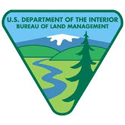July, 2019
The Río Grande del Norte National Monument was established in 2013. It covers a large area, but most is not accessible by anything but four-wheel-drive or else by hiking. The narrow strip along the Rio Grande where highway 64 crosses the river is likely all that people will see passing through.
 New Mexico
New Mexico
This is Taos Plaza, the oldest part of Taos (founded 1615, 1780, or 1934, depending on your definition).
I stayed at the old Taos Inn. It's next door to the plaza and is recommended--and, so is the restaurant.
 Río
Grande del Norte National Monument. This is the entrance several miles
north of Taos.
Río
Grande del Norte National Monument. This is the entrance several miles
north of Taos.
The Rio Grande from the Sheep Crossing viewpoint. From here, there's a steep trail that takes you down to the water.
The joining of the Red River (on the left) with the Rio Grande. It's easy to hear the two rivers, even this high above them.
Ute Mountain (10,097 ft) is just south of the Colorado border. This mountain and all the land beyond to the next mountains on the horizon (looking west) are in the National Monument. The state line marks the northern boundary.
 Colorado
Colorado
North of here is where the Rio Grande begins.
 New Mexico
New Mexico
San Antonio Mountain.
The Sangre de Cristo Mountains. Everything you see across the Taos Plateau (but not the distant mountains) is part of the National Monument.
Cerro Montoso.
It must have been a surprise for the first people to stumble onto this very deep canyon. It isn't obvious until you're right up to it.
The High Bridge (1965).
Below Taos, you'll find old Highway 570 along the Rio Pueblo de Taos. This used to be the route that people would take to cross the river (using the low bridge) and reach the railroad on the west side of the river. A landslide covered this route and a new road was then used from the south. Now, it's a nice hiking trail, which climbs over the old slide.
The Low Bridge is now reached by driving through the small town of Pilar. Of course, all the traffic is now on the newer High Bridge, and there are very few cars down here. The road to the west of the bridge is unpaved for the few miles as it climbs up the canyon wall; the rest is paved.
The Rio Grande having emerged through the canyon and received more water from tributaries along the way.
While most people just stop at the High Bridge, the Río Grande del Norte National Monument is worth an extra day.
